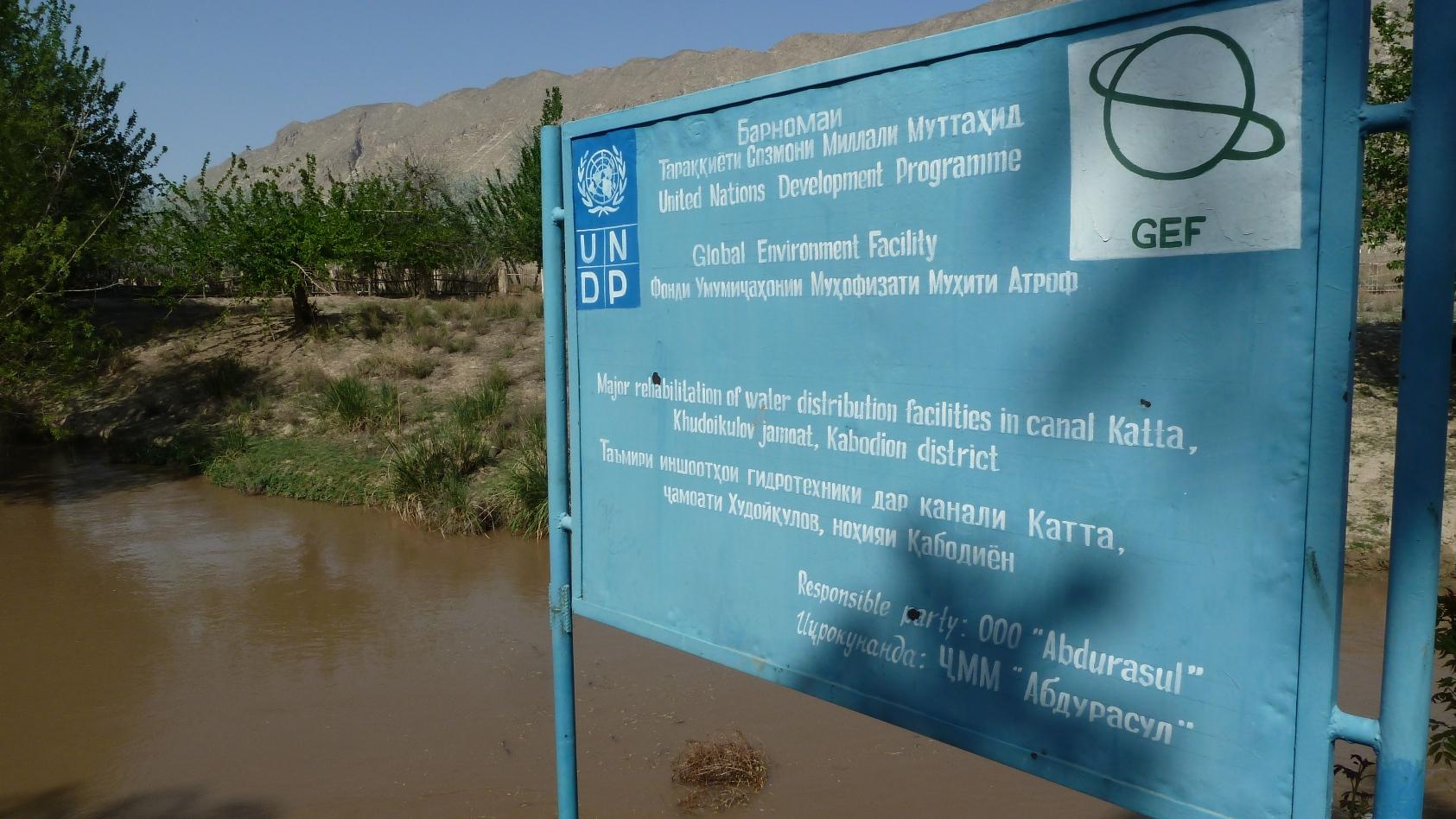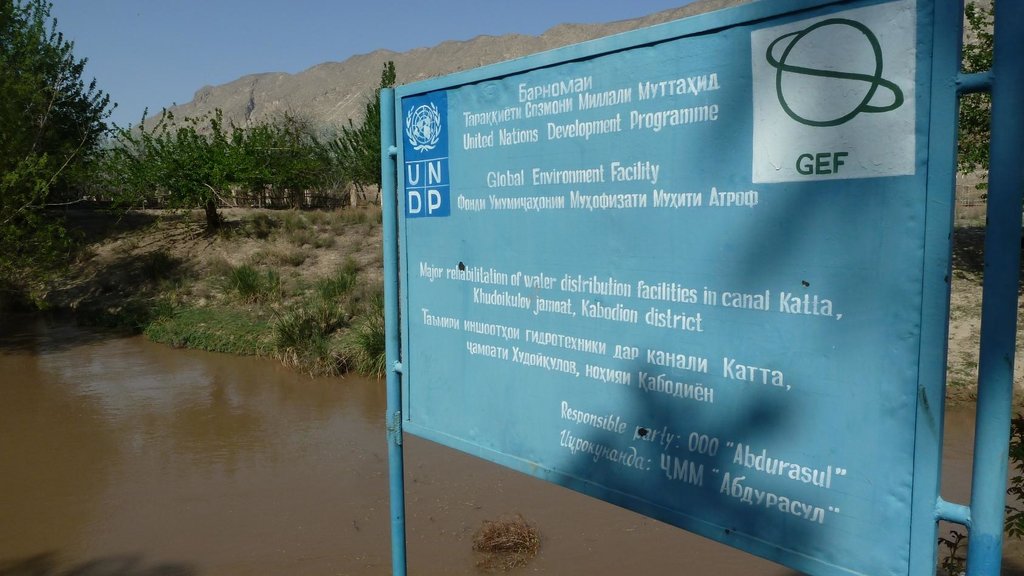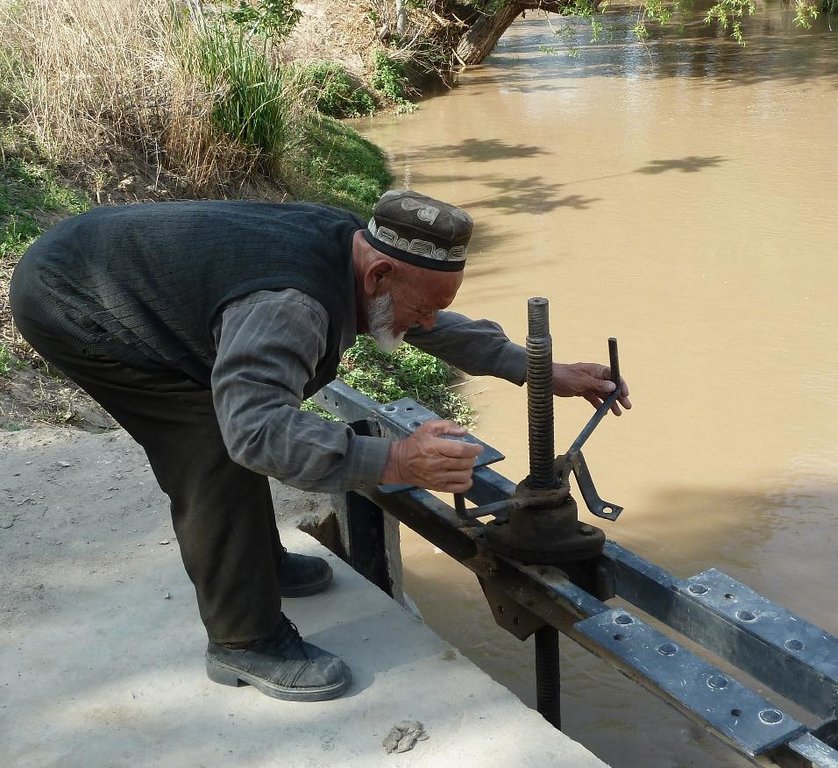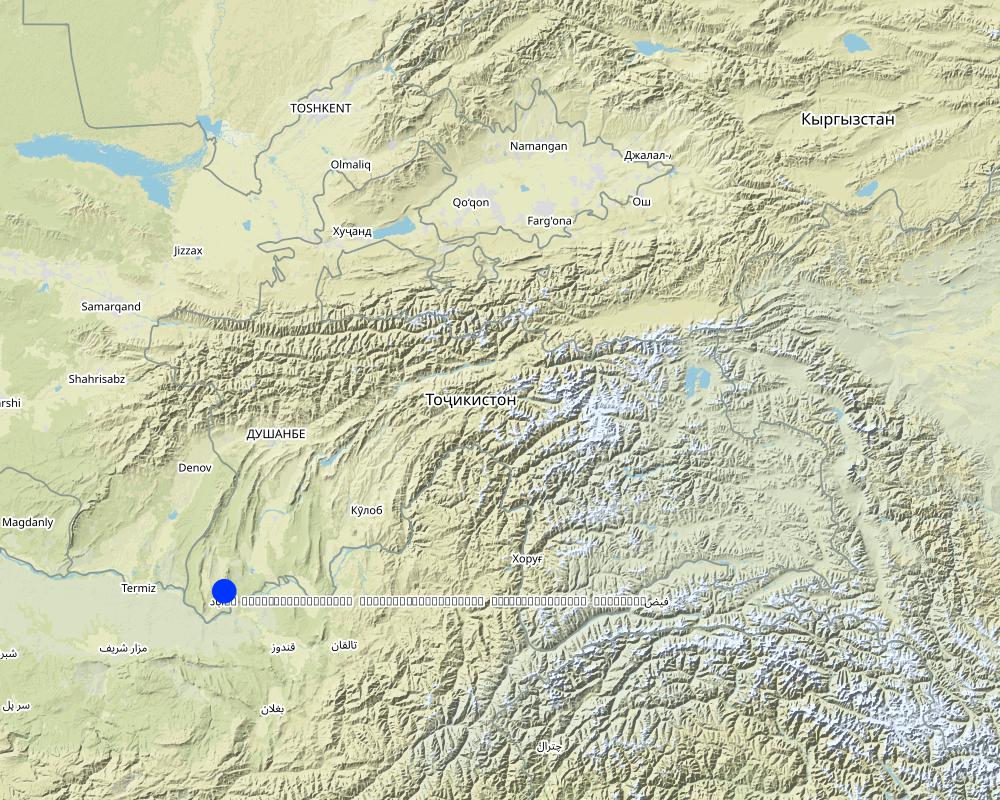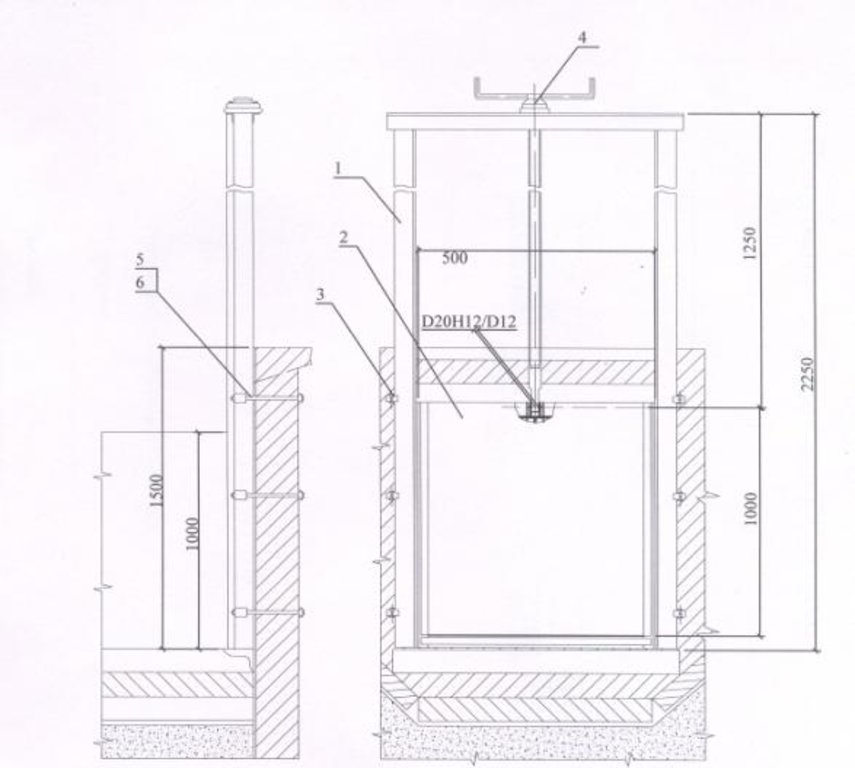Rehabilitation of iron water gates to improve distribution of irrigation water [Tajikistan]
- Creation:
- Update:
- Compiler: Natalia Mityakova
- Editor: –
- Reviewers: Alexandra Gavilano, David Streiff, Joana Eichenberger
technologies_1444 - Tajikistan
- Full summary as PDF
- Full summary as PDF for print
- Full summary in the browser
- Full summary (unformatted)
- Rehabilitation of iron water gates to improve distribution of irrigation water: March 15, 2017 (inactive)
- Rehabilitation of iron water gates to improve distribution of irrigation water: July 20, 2017 (inactive)
- Rehabilitation of iron water gates to improve distribution of irrigation water: Aug. 20, 2019 (inactive)
- Rehabilitation of iron water gates to improve distribution of irrigation water: Nov. 2, 2021 (public)
View sections
Expand all Collapse all1. General information
1.2 Contact details of resource persons and institutions involved in the assessment and documentation of the Technology
SLM specialist:
SLM specialist:
Name of the institution(s) which facilitated the documentation/ evaluation of the Technology (if relevant)
CDE Centre for Development and Environment (CDE Centre for Development and Environment) - SwitzerlandName of the institution(s) which facilitated the documentation/ evaluation of the Technology (if relevant)
United Nations Development Program (United Nations Development Program) - TajikistanName of the institution(s) which facilitated the documentation/ evaluation of the Technology (if relevant)
Central Asian Countries Initiative for Sustainable Land Management - Multicountry Capacity Building (CACILM - MCB) - Kyrgyzstan1.3 Conditions regarding the use of data documented through WOCAT
The compiler and key resource person(s) accept the conditions regarding the use of data documented through WOCAT:
Yes
2. Description of the SLM Technology
2.1 Short description of the Technology
Definition of the Technology:
The recycling of broken iron water gates which can be used to regulate the water flow into smaller side canals were reconstructed along the main irrigation canal.
2.2 Detailed description of the Technology
Description:
This technology is based on the rehabilitation of iron water gates which regulate the water flow into smaller side canals along the main irrigation canal.
Purpose of the Technology: After the collapse of the Soviet Union irrigation facilities in the Shaartuz area were neglected and consequently broke down. In this arid environment, (only about 100 mm annual precipitation) many fields were subsequently abandoned due to a lack of irrigation water. Conflicts arose between people living upstream and downstream along the main irrigation canals as water flow could not be regulated anymore. During the wet spring period the side canals connecting the main canal with the fields had to be monitored day and night, and could only be plugged with vegetative material to protect the fields from flooding. Upstream users received all the water available, and at the same time suffered from waterlogging and water erosion. Downstream users however suffered from a lack of irrigation water, which led to severe conflicts between the different land users.
Establishment / maintenance activities and inputs: In order to help solve these problems, during 2010 UNDP replaced the 32 damaged irrigation gates along the irrigation canal. 12 big and 20 small iron gates were set up to regulate the water flow. Water distribution was regulated according to norms defining water need per ha of irrigated field and taking into account crop and soil types. Farmers then paid for the irrigation water according to those norms. The financial contributions go the Water Agency and are used for canal maintenance. Ideally the channels require cleaning every year as they get filled up with sand and other dirt washed in by the water. Irrigation gates if used appropriately should not need repair for at least the first five years after installation. After that some minor repairs are required which can take up to 4-5 days for the concrete works to be finished and to dry.
Natural / human environment: As a result of the replacement of these water distribution facilities, the irrigation and ameliorative condition of 3,570 ha of land were improved, including around 1,000 ha of kitchen gardens. Around 32,000 people are now benefiting from this intervention. Livelihoods have greatly improved as farmers now feel encouraged to invest in agricultural activities. According to local farmers, now only 1 out of 4 people have to migrate to Russia whereas before the implementation of this sub-project most of them would have been forced to leave the country. As the neglect of irrigation systems from the Soviet times is a problem all over the irrigated lowlands of Tajikistan, this technology could prove highly useful for a more widespread application.
2.3 Photos of the Technology
2.5 Country/ region/ locations where the Technology has been applied and which are covered by this assessment
Country:
Tajikistan
Region/ State/ Province:
Khatlon
Further specification of location:
Kabodion / Khudoikulov
Specify the spread of the Technology:
- evenly spread over an area
If precise area is not known, indicate approximate area covered:
- 10-100 km2
Comments:
around 3'600 ha of land profit from the rehabilitation of water gates
Map
×2.6 Date of implementation
If precise year is not known, indicate approximate date:
- less than 10 years ago (recently)
2.7 Introduction of the Technology
Specify how the Technology was introduced:
- through projects/ external interventions
Comments (type of project, etc.):
2010
3. Classification of the SLM Technology
3.1 Main purpose(s) of the Technology
- access to water
3.2 Current land use type(s) where the Technology is applied

Cropland
- Annual cropping
- Perennial (non-woody) cropping
Annual cropping - Specify crops:
- legumes and pulses - beans
- cereals - wheat (spring)
- vegetables - root vegetables (carrots, onions, beet, other)
- watermelon
Number of growing seasons per year:
- 1
Specify:
Longest growing period in days: 240Longest growing period from month to month: March-October
Comments:
Major land use problems (compiler’s opinion): degradation of vegetation cover, loss of topsoil through wind erosion, access to water is restricted.
Major land use problems (land users’ perception): waterlogging, reduced rational use of water and land resources, flooding, water use conflicts, lack of irrigation water, water erosion
3.4 Water supply
Water supply for the land on which the Technology is applied:
- full irrigation
3.5 SLM group to which the Technology belongs
- irrigation management (incl. water supply, drainage)
3.6 SLM measures comprising the Technology

structural measures
- S3: Graded ditches, channels, waterways
Comments:
Main measures: structural measures
3.7 Main types of land degradation addressed by the Technology

soil erosion by water
- Wg: gully erosion/ gullying

physical soil deterioration
- Pw: waterlogging

water degradation
- Hs: change in quantity of surface water
Comments:
Main type of degradation addressed: Pw: waterlogging, Hs: change in quantity of surface water
Secondary types of degradation addressed: Wg: gully erosion / gullying
Main causes of degradation: over abstraction / excessive withdrawal of water (for irrigation, industry, etc.) (upstream users took all the irrigation water available), inputs and infrastructure: (roads, markets, distribution of water points, other, …) (due to the rundown irrigation facilities, waterflow could not be properly regulated anymore), governance / institutional (after the collapse of the Soviet Union, nobody ensured proper maintenance of the irrigation facilities)
3.8 Prevention, reduction, or restoration of land degradation
Specify the goal of the Technology with regard to land degradation:
- reduce land degradation
- restore/ rehabilitate severely degraded land
Comments:
Secondary goals: prevention of land degradation
4. Technical specifications, implementation activities, inputs, and costs
4.1 Technical drawing of the Technology
Technical specifications (related to technical drawing):
Specifications:
1. Hoist-Head Frame PS-50-100 01.000 – 1 unit
1. Embedded Frame PS-50-100 03.000 – 1 unit
2. Gate PS 50-100 02.000 – 1 unit
3. Backing block PS 50-100 00.001
4. Screw hoist 1 EV TP №820-165 Model B-73 – 1 unit
5. Screw M20x300.4.6.02 State Standard 7798-70 – 6 units
6. Screw nut M20.8.02 State Standard 5915-70 – 6 units
Technical characteristics:
1. Total mass - 90kg
2. Pressure – 1.25m
3. Full hydrostatic pressure – 0.8 ton
4. Rated force – 0.6 ton
Location: Shaartuz. Khatlon
Technical knowledge required for field staff / advisors: high (installation of the water gates)
Technical knowledge required for land users: low
Main technical functions: control of concentrated runoff: drain / divert, water harvesting / increase water supply, water spreading
Waterway
Height of bunds/banks/others (m): 2.25
Width of bunds/banks/others (m): 0.5
Construction material (concrete): concrete
Construction material (other): metal
Author:
UNDP Shaartuz, 2Ziyodaliev Street, Shaartuz
4.2 General information regarding the calculation of inputs and costs
Specify currency used for cost calculations:
- USD
4.3 Establishment activities
| Activity | Timing (season) | |
|---|---|---|
| 1. | Installation of irrigation gates along main irrigation channel |
4.4 Costs and inputs needed for establishment
| Specify input | Unit | Quantity | Costs per Unit | Total costs per input | % of costs borne by land users | |
|---|---|---|---|---|---|---|
| Labour | Installation of irrigation gates | Persons/day | 25.0 | 4.44 | 111.0 | |
| Construction material | Watergate | gates | 1.0 | 300.0 | 300.0 | |
| Total costs for establishment of the Technology | 411.0 | |||||
| Total costs for establishment of the Technology in USD | 411.0 | |||||
If land user bore less than 100% of costs, indicate who covered the remaining costs:
UNDP
4.5 Maintenance/ recurrent activities
| Activity | Timing/ frequency | |
|---|---|---|
| 1. | Cleaning of irrigation channels | annual |
| 2. | Irrigation gates might need some minor repair after 5 years | irregular |
4.6 Costs and inputs needed for maintenance/ recurrent activities (per year)
| Specify input | Unit | Quantity | Costs per Unit | Total costs per input | % of costs borne by land users | |
|---|---|---|---|---|---|---|
| Labour | Cleaning of irrigation channels | Persons/day | ||||
| Labour | Repairing irrigation gate | Persons/day | 5.0 | 4.4 | 22.0 | |
| Total costs for maintenance of the Technology | 22.0 | |||||
| Total costs for maintenance of the Technology in USD | 22.0 | |||||
Comments:
The costs are indicated for the installation of one big water gate.
4.7 Most important factors affecting the costs
Describe the most determinate factors affecting the costs:
The most determinate costs are those for the purchase of water gates. Cleaning of channels was not part of this project, and therefore only installation of water distribution facilities have been completed. Channels are usually cleaned by local users who are in many cases supported by international donors.
5. Natural and human environment
5.1 Climate
Annual rainfall
- < 250 mm
- 251-500 mm
- 501-750 mm
- 751-1,000 mm
- 1,001-1,500 mm
- 1,501-2,000 mm
- 2,001-3,000 mm
- 3,001-4,000 mm
- > 4,000 mm
Agro-climatic zone
- arid
Thermal climate class: temperate
5.2 Topography
Slopes on average:
- flat (0-2%)
- gentle (3-5%)
- moderate (6-10%)
- rolling (11-15%)
- hilly (16-30%)
- steep (31-60%)
- very steep (>60%)
Landforms:
- plateau/plains
- ridges
- mountain slopes
- hill slopes
- footslopes
- valley floors
Altitudinal zone:
- 0-100 m a.s.l.
- 101-500 m a.s.l.
- 501-1,000 m a.s.l.
- 1,001-1,500 m a.s.l.
- 1,501-2,000 m a.s.l.
- 2,001-2,500 m a.s.l.
- 2,501-3,000 m a.s.l.
- 3,001-4,000 m a.s.l.
- > 4,000 m a.s.l.
5.3 Soils
Soil depth on average:
- very shallow (0-20 cm)
- shallow (21-50 cm)
- moderately deep (51-80 cm)
- deep (81-120 cm)
- very deep (> 120 cm)
Soil texture (topsoil):
- coarse/ light (sandy)
Topsoil organic matter:
- low (<1%)
If available, attach full soil description or specify the available information, e.g. soil type, soil PH/ acidity, Cation Exchange Capacity, nitrogen, salinity etc.
Soil fertility is very low
Soil drainage / infiltration is poor
Soil water storage capacity is low
5.4 Water availability and quality
Availability of surface water:
excess
Water quality (untreated):
for agricultural use only (irrigation)
Comments and further specifications on water quality and quantity:
Availability of surface water: Excess in case of heavy rainfall events but at rest of the year the availabilty is poor/none.
5.5 Biodiversity
Species diversity:
- low
5.6 Characteristics of land users applying the Technology
Market orientation of production system:
- mixed (subsistence/ commercial)
Individuals or groups:
- groups/ community
Level of mechanization:
- animal traction
- mechanized/ motorized
Indicate other relevant characteristics of the land users:
Land users applying the Technology are mainly common / average land users
Population density: 50-100 persons/km2
Annual population growth: 2% - 3%
Level of mechanization: Also manual labour.
5.7 Average area of land used by land users applying the Technology
- < 0.5 ha
- 0.5-1 ha
- 1-2 ha
- 2-5 ha
- 5-15 ha
- 15-50 ha
- 50-100 ha
- 100-500 ha
- 500-1,000 ha
- 1,000-10,000 ha
- > 10,000 ha
Is this considered small-, medium- or large-scale (referring to local context)?
- medium-scale
Comments:
Average area of land owned or leased by land users applying the Technology: Also 15-50 ha but less common
5.8 Land ownership, land use rights, and water use rights
Land ownership:
- state
Land use rights:
- communal (organized)
- water is paid
Water use rights:
- communal (organized)
- water is paid
5.9 Access to services and infrastructure
health:
- poor
- moderate
- good
education:
- poor
- moderate
- good
technical assistance:
- poor
- moderate
- good
employment (e.g. off-farm):
- poor
- moderate
- good
markets:
- poor
- moderate
- good
energy:
- poor
- moderate
- good
roads and transport:
- poor
- moderate
- good
drinking water and sanitation:
- poor
- moderate
- good
financial services:
- poor
- moderate
- good
6. Impacts and concluding statements
6.1 On-site impacts the Technology has shown
Socio-economic impacts
Production
crop production
Comments/ specify:
indirect benefit
production area
Comments/ specify:
Previously the rehabilitation of water distribution facilities land was abandoned
Water availability and quality
water availability for livestock
Comments/ specify:
water for household needs
irrigation water availability
Income and costs
workload
Comments/ specify:
Previously the gates had to be monitored all the time
Socio-cultural impacts
food security/ self-sufficiency
conflict mitigation
Comments/ specify:
reduced conflicts about water availability
Livelihood and human well-being
Comments/ specify:
Farmers feel more confident about investing in other agricultural activities as they can rely on having access to irrigation water which prevents them from needing to migrate for work.
Ecological impacts
Water cycle/ runoff
water quantity
harvesting/ collection of water
surface runoff
excess water drainage
Climate and disaster risk reduction
drought impacts
6.2 Off-site impacts the Technology has shown
water availability
6.3 Exposure and sensitivity of the Technology to gradual climate change and climate-related extremes/ disasters (as perceived by land users)
Gradual climate change
Gradual climate change
| Season | increase or decrease | How does the Technology cope with it? | |
|---|---|---|---|
| annual temperature | increase | well |
Climate-related extremes (disasters)
Meteorological disasters
| How does the Technology cope with it? | |
|---|---|
| local rainstorm | not well |
| local windstorm | well |
Climatological disasters
| How does the Technology cope with it? | |
|---|---|
| drought | well |
Hydrological disasters
| How does the Technology cope with it? | |
|---|---|
| general (river) flood | not well |
Other climate-related consequences
Other climate-related consequences
| How does the Technology cope with it? | |
|---|---|
| reduced growing period | well |
Comments:
Flood diversion channels were built and so in case of floods there is an emergency system in place.
6.4 Cost-benefit analysis
How do the benefits compare with the establishment costs (from land users’ perspective)?
Short-term returns:
neutral/ balanced
Long-term returns:
very positive
How do the benefits compare with the maintenance/ recurrent costs (from land users' perspective)?
Short-term returns:
positive
Long-term returns:
positive
6.5 Adoption of the Technology
- > 50%
Of all those who have adopted the Technology, how many did so spontaneously, i.e. without receiving any material incentives/ payments?
- 0-10%
Comments:
100% of land user families have adopted the Technology with external material support
Comments on spontaneous adoption: UNDP paid for installation of water gates
There is a moderate trend towards spontaneous adoption of the Technology
Comments on adoption trend: however the only issue with installation of water gates is that they require a sufficient amount of funding (mostly external).
6.7 Strengths/ advantages/ opportunities of the Technology
| Strengths/ advantages/ opportunities in the land user’s view |
|---|
| Reduced conflicts about water distribution as previously upstream users received all the available water and downstream users received nothing |
| Reduced workload as previously gates had to be constantly monitored |
| Improved livelihoods due to regular water access |
| Increased confidence of farmers to invest in other agricultural activities due to more guaranteed water availability |
| Less migration to Russia as income opportunities through agriculture have improved |
| Strengths/ advantages/ opportunities in the compiler’s or other key resource person’s view |
|---|
|
Improved regulation of water flow as previously some areas suffered from flooding and waterlogging whereas others did not receive enough water. How can they be sustained / enhanced? Ensure proper maintenance of the facilities |
6.8 Weaknesses/ disadvantages/ risks of the Technology and ways of overcoming them
| Weaknesses/ disadvantages/ risks in the compiler’s or other key resource person’s view | How can they be overcome? |
|---|---|
| High costs involved with the installation of such an irrigation system along a whole canal | If every collective farm along the river pays for the gates within their territory, the costs could be divided between them. |
7. References and links
7.1 Methods/ sources of information
Links and modules
Expand all Collapse allLinks
No links
Modules
No modules


